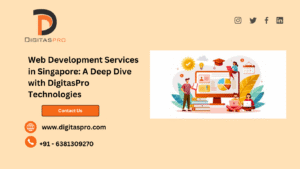Introduction
Web development continues to evolve rapidly. In 2026, mastering web development requires a strategic approach, especially for beginners navigating a sea of frameworks, tools, and best practices. Fortunately, there’s a wealth of high-quality, free resources to learn from. This guide by DigitasPro Technologies provides a detailed, beginner-to-advanced roadmap with only free resources, helping you become a professional web developer without spending a cent.
Section 1: Understanding Web Development
Brief: A foundational overview of web development and its major domains.
Web development involves building websites and web apps that function on the internet. It includes three main areas:
- Frontend (Client-side): Everything users see and interact with.
- Backend (Server-side): Databases, server logic, and APIs.
- Full Stack: A combination of both frontend and backend.
Section 2: Frontend Development Roadmap
Brief: Step-by-step path to mastering frontend skills.
Step 1: Learn the Building Blocks
- HTML5, CSS3, JavaScript (ES6+)
- Free Resources:
Step 2: CSS Frameworks and Preprocessors
- Tools: Tailwind CSS, Bootstrap, Sass
- Free Resources:
Step 3: JavaScript Deep Dive
- DOM Manipulation, Events, ES Modules, Fetch API
- Free Resources:
Step 4: Learn a Frontend Framework
- React.js (Most in-demand)
- Alternatives: Vue, Svelte
- Free Resources:
Step 5: Responsive Design & Accessibility
- Mobile-first design, ARIA roles, semantic HTML
- Free Resources:
Section 3: Version Control (Git & GitHub)
Brief: Learn Git for tracking changes and collaborating.
- Git basics: init, clone, commit, push
- GitHub: Forks, Pull Requests, Issues
- Free Resources:
Section 4: Backend Development Roadmap
Brief: Learn to manage data, servers, and business logic.
Step 1: Choose a Language
- Options: Node.js (JavaScript), Python, Ruby
- Free Resources:
Step 2: Learn Databases
- Relational (MySQL, PostgreSQL), NoSQL (MongoDB)
- Free Resources:
Step 3: Learn APIs and REST
- CRUD operations, RESTful APIs, GraphQL
- Free Resources:
Step 4: Authentication
- OAuth, JWT, Session Auth
- Free Resources:
Section 5: Full Stack Development
Brief: Combine frontend and backend skills to become full stack.
Popular stacks:
- MERN (MongoDB, Express, React, Node.js)
- Django + React
Free Full Stack Programs:
Section 6: Deployment & DevOps
Brief: Get your projects online.
Frontend Deployment:
- Vercel, Netlify
Full Stack Deployment:
- Render, Railway, Fly.io
Basics of Docker and CI/CD:
- Free Resources:
Section 7: Web Performance Optimization
Brief: Make websites faster and more efficient.
Key topics:
- Lazy loading, compression, caching
- Lighthouse, WebPageTest
Free Tools:
Section 8: Free Learning Platforms
Brief: The best free platforms to learn web development in 2026.
Top picks:
Section 9: Projects You Should Build in 2026
Brief: Real-world projects for your portfolio.
| Level | Project | Stack |
|---|---|---|
| Beginner | Portfolio Website | HTML, CSS, JS |
| Intermediate | Task Manager | React, Node, MongoDB |
| Advanced | E-commerce Platform | Next.js, Stripe |
Section 10: Career Pathways
Brief: Tips to transition from learning to earning.
High-demand roles:
- Frontend Developer (React, TypeScript)
- Backend Developer (Node.js, Express)
- Full Stack Engineer
- DevOps Junior Engineer
Certifications:
FAQ
Q1: Can I become a web developer in 2026 with no coding background?
Yes! With dedication and the right free resources, you can start from scratch and become a web developer.
Q2: What stack should I learn first?
The MERN stack (MongoDB, Express, React, Node.js) is highly recommended due to its popularity and job demand.
Q3: How long does it take to become job-ready?
With consistent effort, you can be ready in 6–12 months depending on your learning pace.
Q4: Are the certifications listed truly free?
Yes, all listed certification programs offer free tracks. Some may charge for optional verified certificates.
Q5: What’s the best way to practice?
Build real projects, contribute to open source, and use platforms like GitHub to showcase your work.

